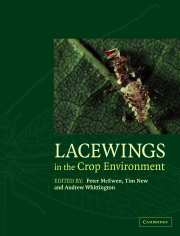Book contents
- Frontmatter
- Contents
- List of contributors
- Preface
- PART 1 Lacewing systematics and ecology
- PART 2 Lacewings in crops
- PART 3 Principles
- PART 4 Case studies
- Introduction to Part 4
- CHAPTER 18 Micromus tasmaniae: a key predator on aphids on field crops on Australasia?
- CHAPTER 19 Preliminary notes on Mallada signatus (Chrysopidae) as a predator in field crops in Australia
- CHAPTER 20 An evaluation of lacewing releases in North America
- CHAPTER 21 Chrysoperla externa and Ceraeochrysa spp.: potential for biological control in the New World tropics and subtropics
- CHAPTER 22 Comparative plant substrate specificity of Iberian Hemerobiidae, Coniopterygidae, and Chrysopidae
- CHAPTER 23 Lacewings in Sardinian olive groves
- CHAPTER 24 Lacewing occurrence in the agricultural landscape of Pianura Padana
- CHAPTER 25 Lacewings and snake-flies in Piedmont vineyards (northwestern Italy)
- CHAPTER 26 Control of aphids by Chrysoperla carnea on strawberry in Italy
- CHAPTER 27 Artificial overwintering chambers for Chrysoperla carnea and their application in pest control
- CHAPTER 28 Lacewings in Andalusian olive orchards
- CHAPTER 29 The green lacewings of Romania, their ecological patterns and occurrence in some agricultural crops
- CHAPTER 30 Biological control with Chrysoperla lucasina against Aphis fabae on artichoke in Brittany (France)
- PART 5 Conclusion
- Taxonomic index
- General index
CHAPTER 30 - Biological control with Chrysoperla lucasina against Aphis fabae on artichoke in Brittany (France)
Published online by Cambridge University Press: 04 May 2010
- Frontmatter
- Contents
- List of contributors
- Preface
- PART 1 Lacewing systematics and ecology
- PART 2 Lacewings in crops
- PART 3 Principles
- PART 4 Case studies
- Introduction to Part 4
- CHAPTER 18 Micromus tasmaniae: a key predator on aphids on field crops on Australasia?
- CHAPTER 19 Preliminary notes on Mallada signatus (Chrysopidae) as a predator in field crops in Australia
- CHAPTER 20 An evaluation of lacewing releases in North America
- CHAPTER 21 Chrysoperla externa and Ceraeochrysa spp.: potential for biological control in the New World tropics and subtropics
- CHAPTER 22 Comparative plant substrate specificity of Iberian Hemerobiidae, Coniopterygidae, and Chrysopidae
- CHAPTER 23 Lacewings in Sardinian olive groves
- CHAPTER 24 Lacewing occurrence in the agricultural landscape of Pianura Padana
- CHAPTER 25 Lacewings and snake-flies in Piedmont vineyards (northwestern Italy)
- CHAPTER 26 Control of aphids by Chrysoperla carnea on strawberry in Italy
- CHAPTER 27 Artificial overwintering chambers for Chrysoperla carnea and their application in pest control
- CHAPTER 28 Lacewings in Andalusian olive orchards
- CHAPTER 29 The green lacewings of Romania, their ecological patterns and occurrence in some agricultural crops
- CHAPTER 30 Biological control with Chrysoperla lucasina against Aphis fabae on artichoke in Brittany (France)
- PART 5 Conclusion
- Taxonomic index
- General index
Summary
INTRODUCTION
In Brittany artichokes, Cynara scolymus L., are cultivated widely along the Channel coast, where the climate is favourable to this crop. Aphids are considered as the main pests of this vegetable in this area, mainly: Capitophorus horni (Börner) (the green aphid) and Aphis fabae (Scop.) (the black aphid) (Maisonneuve et al., 1981; Collet, 1997). To control these aphids, the growers are developing a system of integrated pest management (IPM), in order to increase the quality of this important crop of our country: at present 50000 metric tonnes are produced on about 7–9000 hectares.
In many countries Chrysopa spp. or Chrysoperla spp. are used to control aphids on field vegetable crops. As part of the interest in this predator (Lyon, 1976, 1979; Sengonca, 1995) to control aphids, Chrysoperla lucasina has been investigated in 1995 and 1996 in artichokes and shows some promise (Malet et al., 1994) and is easy to rear.
In order to appreciate the impact of this beneficial insect on artichoke, in our experiments we have examined the development of aphids and some lady beetles (Coccinellidae). These experiments are described here, to indicate the preliminary assessment for using Chrysopidae to control aphids on artichokes in France.
MATERIALS AND METHODS
The experiments below are described and discussed with relevance to the years 1996 and 1997. The work was carried out on second-year crops of ‘Camus de Bretagne’ artichokes. The duration of a plantation is usually three years.
- Type
- Chapter
- Information
- Lacewings in the Crop Environment , pp. 513 - 518Publisher: Cambridge University PressPrint publication year: 2001
- 3
- Cited by



